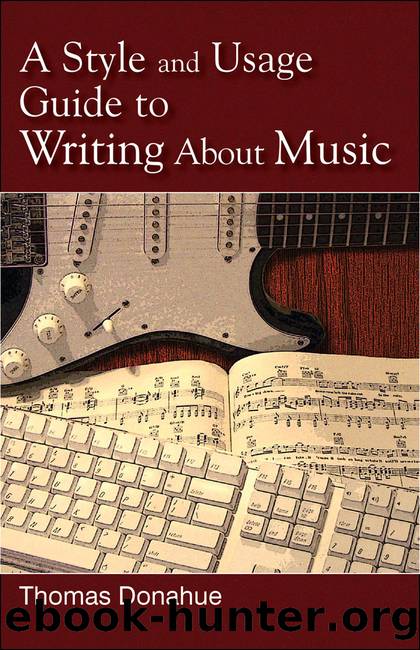A Style and Usage Guide to Writing About Music by Donahue Thomas;

Author:Donahue, Thomas;
Language: eng
Format: epub
ISBN: 1776352
Publisher: Scarecrow Press
appoggiatura da capo aria quodlibet
arpeggio dal segno aria ripieno
avant-garde falsetto ritornello
basso continuo frottola rondeau
bicinium glissando scordatura
cadenza libretto soprano
castrato oeuvre stretto
clausula opus tessitura
coda organum tremolo
coloratura ostinato tutti
concerto grosso pizzicato vibrato
ballade. This refers to several types of musical works (one of the three formes fixes; a narrative poem or song in German; piano works of Chopin, Liszt, and Brahms) but since they are all compositions, the term would be lowercase roman type when used as a genre, capitalized roman type when used as a specific title.
Cammerton, Chorton. These are both capitalized German nouns; retaining the capitalization is suggested. If used rarely, italicize them. Otherwise, italicize at their first occurrence and use roman type thereafter.
cantus firmus. This term is evenly split in the references: half use italics, half use roman type. The case for roman type is that the term does not resemble any English words and would never be confused with any other term.
conductus. This is a genre, and so would be in roman type, but italicizing its first occurrence would alert the reader.
da capo, dal segno. If used as part of a genreâda capo aria, dal segno ariaâuse roman type. If used in other contextsâsuch as a discussion of ornaments added to a da capo sectionâitalics may be used.
divertissement. If used as a genre (like divertimento), use roman type. If used as a French word in a French context, use italics.
entrée. This term may be used as a genre term, but it also has many subtle meanings and does not seem to be an assimilated term. Use italics.
fauxbourdon. This term can be used in roman type (italicized at its first appearance) if it is the main topic of an essay. If being used in a context in which it is necessary to distinguish it from similar termsâfalsobordone, faburdenâitalics may prove useful.
obbligato. This is seen so often it probably should be considered an assimilated term. Use roman type.
5.13. Word as word. When one discusses a word as a wordâfor example, the four-letter term âoboeâ and not the woodwind instrument so namedâthe word may be either italicized or in roman type and quotation marks. Many style guides opt for italics, but just as many accept either option. Sometimes the selection of one practice over another may be a subtle distinction as to how the sentence looks, or may simply be personal preference. In the first two pairs of example sentences that follow, either format seems appropriate. (It should be mentioned that the guidelines that the word âsonataâ as a genre would normally be in roman type and the word âcantabileâ as a performance term would normally be in italics are overruled by the current guideline.) In the third pair of sentences, the use of italics may have the advantage of producing a less cluttered look. (See another example of this in section 5.4.)
Both D. Scarlatti and Mozart used the term sonata.
or
Both D. Scarlatti and Mozart used the term âsonata.â
My teacher wrote the word cantabile in m. 79.
or
My teacher wrote the word âcantabileâ in m.
Download
This site does not store any files on its server. We only index and link to content provided by other sites. Please contact the content providers to delete copyright contents if any and email us, we'll remove relevant links or contents immediately.
Aircraft Design of WWII: A Sketchbook by Lockheed Aircraft Corporation(32139)
The Great Music City by Andrea Baker(30795)
Call Me by Your Name by André Aciman(19927)
The Art of Boudoir Photography: How to Create Stunning Photographs of Women by Christa Meola(18414)
The Secret History by Donna Tartt(18210)
Shoot Sexy by Ryan Armbrust(17563)
Plagued by Fire by Paul Hendrickson(17118)
Portrait Mastery in Black & White: Learn the Signature Style of a Legendary Photographer by Tim Kelly(16877)
Adobe Camera Raw For Digital Photographers Only by Rob Sheppard(16805)
Photographically Speaking: A Deeper Look at Creating Stronger Images (Eva Spring's Library) by David duChemin(16504)
Ready Player One by Cline Ernest(14023)
Pimp by Iceberg Slim(13797)
Bombshells: Glamour Girls of a Lifetime by Sullivan Steve(13698)
The Goal (Off-Campus #4) by Elle Kennedy(13207)
Art Nude Photography Explained: How to Photograph and Understand Great Art Nude Images by Simon Walden(12858)
Kathy Andrews Collection by Kathy Andrews(11340)
The Priory of the Orange Tree by Samantha Shannon(8630)
Thirteen Reasons Why by Jay Asher(8466)
The remains of the day by Kazuo Ishiguro(8410)
